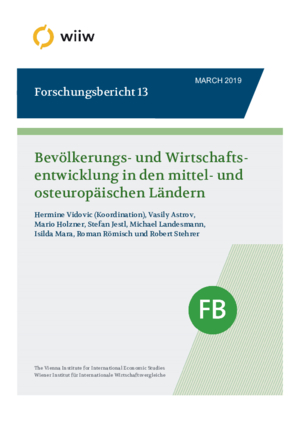Bevölkerungs- und Wirtschaftsentwicklung in den mittel- und osteuropäischen Ländern
Vasily Astrov, Mario Holzner, Stefan Jestl, Michael Landesmann, Isilda Mara, Roman Römisch, Robert Stehrer and Hermine Vidovic
wiiw Research Report in German language No. 13, March 2019
115 pages including 59 Tables, 33 Figures and 7 Maps
This publication is available in German language only.
For a brief English summary see further below.
Der Zustrom aus den mittel- und osteuropäischen Ländern (MOEL) spielte eine wichtige Rolle bei der Bevölkerungsentwicklung in Österreich und Wien zwischen 2000 und 2016. Dies hat auch zu einer signifikanten Veränderung der Beschäftigungsstruktur in Wien geführt, die teilweise zu einer Verdrängung inländischer und anderer ausländischer Arbeitnehmer führte. Die Studie gibt eine Einschätzung des aktuellen und zukünftigen Migrationspotenzials nach Österreich und Wien aus den MOEL und zwei Westbalkanländern, Bosnien und Herzegowina und Serbien. Die wirtschaftliche Entwicklung in den MOEL ist seit einigen Jahren sehr positiv, und auch die Prognosen deuten auf ein stetiges Wirtschaftswachstum mit deutlich höheren Wachstumsraten als im EU-Durchschnitt hin. Damit einhergehend hat sich die Arbeitsmarktsituation in diesen Ländern insgesamt verbessert. Dies und die allgemeine demographische Entwicklung in der Region führen zu einer Verlangsamung der Mobilitätsströme aus den MOEL. Dennoch ist die demographische Entwicklung in der Region und auf dem Westbalkan nach wie vor besorgniserregend, da die Bevölkerung (insbesondere jene im erwerbsfähigen Alter) schrumpft. Demographische Langzeitszenarien gehen davon aus, dass die Bevölkerung in der Region in den kommenden Jahrzehnten weiter stark zurückgehen wird. Diese Entwicklungen deuten auf eine Abflachung der Trends hin, wenn nicht sogar auf eine mittelfristige Schwächung der bestehenden Mobilitätsströme nach Österreich und Wien. Es gibt auch keine Hinweise darauf, dass sich die regionale Struktur der Migrationsströme in Hinblick auf die österreichischen Bundesländer stark verschieben wird.
English Summary
Population trends and economic development in Central and East European countries
The influx from Central and East European countries (CEECs) played an important role in population trends in Austria and Vienna between 2000 and 2016. This has also led to a significant change in the employment structure in Vienna, partly resulting in the displacement of both domestic and other foreign workers. The study assesses the current and future migration potential to Austria and Vienna from the CEECs and two Western Balkan countries, Bosnia and Herzegovina and Serbia. Economic developments in the CEECs have been very positive for some years already and forecasts also point to steady economic growth with significantly higher growth rates than the EU average. In line with this, the labour market situation in these countries has generally improved. This and the general demographic developments in the region lead to a slowdown in mobility flows from CEECs. Nonetheless, demographic developments in the region and the Western Balkans remain worrying as population is shrinking and the working-age population even more so. Demographic long-term scenarios suggest that the population in the region will continue to shrink sharply in the coming decades. These developments point towards a flattening of trends, if not a weakening of existing mobility flows to Austria and Vienna in the medium term. Finally, there are no indications that the patterns of mobility flows to Austrian regions (i.e. with respect to individual provinces) will shift significantly.
Reference to wiiw databases: wiiw Annual Database
Keywords: Demographie, regionale Entwicklung, Arbeitsmarkt, Migration, demography, regional development, labour market
JEL classification: J11, J31, J61, J64, O50
Countries covered: Austria, Bosnia and Herzegovina, New EU Member States, Serbia
Research Areas: Macroeconomic Analysis and Policy, Labour, Migration and Income Distribution, Regional Development
